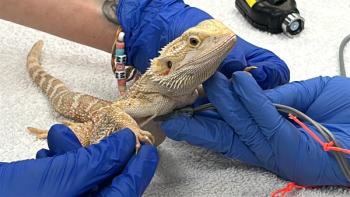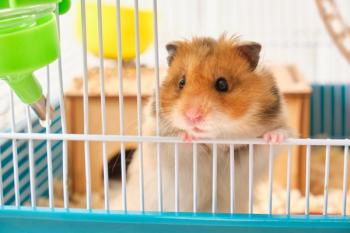
Antimicrobial use in exotics (Proceedings)
In order to use antimicrobial drugs in exotic patients effectively, one has to understand both the basic pharmacokinetics of these drugs, as well as certain key physiological features of the species being treated (e.g. a poikilotherm animal vs. a homeotherm). One mayor problem in the use of antimicrobial drugs approved for dogs and cats in exotic species, is the fact that there is little clinical data available on the use of these drugs in exotic patients.
Objectives of the Presentation
• How to use different antimicrobial drugs safely and effectively in the exotic animal patient.
Key Points
• there are many antimicrobials available for use in exotic species
• only a few are contraindicated in specific species
• it is important to understand the key physiological features which impact drug choice in certain species
• a good formulary for exotics will help clarify these species specific differences
In order to use antimicrobial drugs in exotic patients effectively, one has to understand both the basic pharmacokinetics of these drugs, as well as certain key physiological features of the species being treated (e.g. a poikilotherm animal vs. a homeotherm). One mayor problem in the use of antimicrobial drugs approved for dogs and cats in exotic species, is the fact that there is little clinical data available on the use of these drugs in exotic patients. While more and more pharmacological data is becoming available regarding the use of antimicrobials in exotics (mainly birds and reptiles), for the majority of the drugs used in the clinical setting in the different species, no exact figures have been published.
A specific diagnosis should be the foundation for the treatment choice in order to achieve the best results from the antimicrobial treatment. Drug choice based on a reliable culture and sensitivity helps avoid dispensing ineffective drugs and thus losing valuable treatment time. It is also important to remember that in many cases a systemic infection in the exotic patient is the result of a prolonged period of stress, and resulting immune suppression, and it is therefore of utmost importance not only to treat the infection but also to identify the underlying problem causing the stress. In poikilothermic pets (reptiles, amphibians, and fish) the underlying stressor is most likely an environmental problem such as inappropriate temperature or humidity. Chronic malnutrition is often also part of the problem. Once the underlying problem has been identified and corrected, treatment of the infection should be started. Often, and especially in severe cases, the animals will also need additional supportive care in order to maximize the success of the antimicrobial treatment.
The choice of an antimicrobial drug should be based both on the results of the culture and sensitivity, and on other pharmacological parameters. Some of the factors to consider in the choice of the appropriate antimicrobial drug are:
• The ability of the drug to reach therapeutic concentrations in specific tissues (e.g. CNS, bone, eye)
• Route of administration (e.g. certain drugs can only be given intravenously)
• Toxicity after prolonged treatment (e.g. Metronidazole)
• Concentration of drug available from manufacturer
• Species in which the drug can be used safely
Administration
Oral administration is the preferred route of drugs in most exotic patients since it can often be easily managed at home, and it is also the least invasive route of drug delivery.
If the drug must to be given via the parenteral route, subcutaneous delivery is best. Often drugs can be added if fluids are being given subcutaneously to correct hydration deficits.
In birds the intramuscular route works well and drugs are commonly administered into the (generally) large pectoral muscle mass. Reptiles also usually have large muscle groups that can be used for intramuscular injections. In small mammals however, this route is less optimal, due to the lack of large muscle masses. When necessary hind leg musculature can be used.
The intravenous and intraosseus routes are possible in the hospitalized patient and are the preferred way to administer drugs quickly and accurately. In both birds and reptiles, intraosseus catheters can easily be placed and the fluid absorption through these catheters is equal to that obtained with intravenous access.
Topical application of antimicrobials can be used as an adjunct to systemic antibiotic treatments, but in most cases should not be the sole route of antibiotic delivery. In most cases a systemic infection is present, even when the clinical signs appear to be limited to one region (e.g. ear, eye).
"Pulse therapy" is a relatively new protocol for antibiotic treatment that has been described. In this protocol a single high dose of the antibiotic is given once a day rather than administering multiple smaller doses over the day. The idea utilizes the 'post antibiotic effect" of certain antibiotics. These drugs retain their efficacy even as the concentrations decreases. Not all drugs appear to be suitable for this use and currently only the fluroquinolones and amikacin are recommended as 'pulsing' agents. This form of drug delivery could obviously prove to be very useful in highly stress-prone animals where multiple handlings per day could be contraindicated.
Drugs:
Amikacin:
Amikacin is a bacteriocidal aminoglycocide with good efficacy against gram negative bacteria. It is used frequently in reptile medicine, and occasionally in small mammals, where an infection with Pseudomonas has been diagnosed. The two greatest disadvantages in the use of this drug are the potential for nephrotoxicity, and its poor absorption from the GI tract. The potential for nephrotoxicity makes it vital to ensure that the animal is properly hydrated when using this drug and it is recommended to administer it with concomitant fluid therapy.
In order to avoid further risk of nephrotoxocity the reptile patient should be keep at a slightly lower temperature than usual to avoid the fully effect of tissue damage in the kidneys.
In rabbits with chronic upper respiratory infections caused by Pseudomonas, nasal drops using ophthalmic preparations can be used successfully. For birds with respiratory tract infections it is great to use in a nebulizer together with acetylcysteine and aminophylline.
The activity of amikacin is :
+++ for Gram - ; ++ for Gram +; + for Mycoplasma and ++ for Pseudomonas. The drug is excellent for infections with E. coli, Klebsiella, Proteus, Salmonella, Enterobacter, Serratia, Shigella, Staphylococcus.
Betalactams (cephalosporins and penicillins):
The betalactams are bacteriocidal antimicrobials, and the third generation of these drugs have significant efficacy against many gram negative bacteria. However only a few drugs in this group i.e. cefotaxime reach adequate therapeutic concentration in the CNS. Cefixime is the only oral third generation cephalosporin antibiotic on the market. Most of the betalactams should not be administered orally in hindgut fermenters such as rabbits and hamsters since oral administration of these drugs can cause fatal dysbacteriosis in these species. However, the parental route of administration is usually well tolerated. For example, Penicillin G is the treatment of choice for rabbit syphilis (Treponema cuniculi) and it an effective treatment choice in many tooth root abscess cases. Ceftazidime is the authors first drug of choice for many systemic infections in the reptilian patient.
The activity for 3rd generation betalactams is:
+++ for Gram - ; +++ for Gram +; and ++ for Pseudomonas
Fluoroquinolones:
These are considered to be bacteriocidal agents but the true mechanism of action is not known. This effect is concentration dependent, with susceptible bacteria cell death occuring within 20-30 minutes of exposure. Baytril (Enrofloxacin) is active in both stationary and growth phases of bacterial replication and has demonstrated a significant post-antibiotic effect making it an effective choice for the "pulse" therapy. The quinolones have a broad spectrum of activity including efficacy against both mycoplasma and Chlamydiophyla. The pharmacokinetic properties of the different members of the fluroquinolones can be significantly different. They appear relatively safe when used at recommended doses. Baytril has been used orally in herbivores without problems, even for prolonged periods of time (months).
The activity of fluoroquinolones are:
+++ for Gram - ; +++ for Gram +; ++ for Mycoplasma, + for Chlamydiophyla and + for Pseudomonas (many resistant strains exist). The drug is excellent for infections with Klebsiella sp., E. coli, Enterobacter, CampylobacterShigella,Salmonella, Aeromonas, Haemophilus, Proteus, Yersinia and Vibrio.
Sulfonamides:
Sulfonamides are considered bactericidal when used in combination with a potentiator such as Trimethoprim. Potentiated sulfa drugs are extremely well absorbed orally and have a broad spectrum of activity. They can be safely used in herbivores and are well tolerated. However these drugs can have nephrotoxic effects and therefore should not be used in dehydrated patients.
The activity of potentiated sulfonamides are:
+++ for Gram - ; +++ for Gram +; and ++ for Coccidia (good for Pneumocystis carinii, Coccidia, and Toxoplasma)
Chloramphenicol/Florfenicol:
Chloramphenicol and Florfenicol are bacteriostatic drugs with good activity against a wide antimicrobial spectrum including many anaerobes e.g.Clostridium, Bacteriodes, Fusarium, as well as Mycoplasma and Chlamydiophila. These drugs are well absorbed after oral administration and can be given by injection either subcutaneously or intramuscularly. However they cannot be intravenously. These drugs achieve high concentration is the CNS, the eyes and in the liver. Caution should be used in handling Chloramphenicol as it has the potential to induce an aplastic anemia in humans so great care must be taken when dispensing it for home use by the owner. Florfenciol, however, does not cause this problem. These drugs should not be used in neonatal animals or in lactating females due to the possibility to induce the 'grey baby syndrome' a potential toxicity.
The activity of Chloramphenicol and Florfenicol are:
++ for Gram - ; ++ for Gram +; ++ for Anaerobes; + for Mycoplasma, and + for Chlamydiophyla The drug is excellent for infections with Neissiera,Brucella, Salmonella, Shigella, Haemophilus Pasteurella haemolytica, Pasteurella multocida (Gram -) and Streptococci, Staphylococci (Gram-) and Clostridum, Bacteroides, Fusobacterium, Veillonella (anaerobes).
Metronidazole:
Metronidazole is a nitroimidazole with both bacteriocidal and antiprotozoal properties. The exact mechanism of the bacteriocidal activity is not perfectly understood. It is commonly commonly used to treat anaerobic bacterial infections and giardia infections in birds. It is well absorbed after oral administration, and reaches high concentrations in several different tissues including the CNS. However prolonged administration can cause neurologic signs (often fatal in reptiles)! Metronidazole is also one of the drugs used for the treatment of helicobacter infections in ferrets. The author routinely uses it in dental abscesses in rabbits with good success.
The activity of Metronidazole is:
+++ for Anaerobes (Bacteroides sp. Fusobacterium, Veillonella, Clostridium sp., peptococcus, peptostreptococcus.) and +++ for Protozoans (Entamoeba histolytica, Trichomonas, Giardia, and Balantidium coli.)
Tetracyclines:
Tetracyclines are bacteriostatic drugs with a broad spectrum of activity, and good tissue concentrations after oral administration. If fact, oral administration provides better tissue distribution than intramuscular injection. They are the drugs of choice for treatment of chlamydiophila infections in birds. The tetracyclines are relatively unstable when mixed in water and so if used in drinking water a fresh solution must be prepared daily to maintain effectiveness.
The use of longacting injections are commonly used in birds (either LA-200 or Vibravenous)
The activity of tetracyclines are:
++ for Gram - ; ++ for Gram +; +++ for Mycoplasma, +++ for Chlamydiophyla. The drug is excellent for infections with Bordetella sp., Brucella, Bartonella, Haemophilus sp., Pasturella multocida, Shigella, and Yersinia pestis (G -). Actinomyces sp., Bacillus anthracis, Clostridium perfringens and tetani, Listeria monocytogenes, Nocardia (G +).
Tylosin:
Tylosin is a macrolide, bacteriostatic antibiotic. It is similar in structure, mechanism of action, and spectrum as that of Erythromycin.
Although well distributed systemically, after absorption, it does not penetrate cerebral spinal fluid well.It is concentrated in the liver and excreted unchanged in the urine and bile. It is used in treating mild to moderately severe forms of respiratory tract, skin, and soft tissue infections caused by group A beta-hemolytic streptococci and mycoplasma pneumoniae. It is also used in the treatment of colitis. It is a commonly used drug for rats with chronic respiratory disease and in reptiles (turtles) with mycoplasma infections. In small animals, tylosin is used for its anti-inflammatory properties in the large intestine rather than for its ability to fight infection.
The activity of tylosin is:
+++ for Mycoplasma.
Legal notice
Many veterinarians often prescribe different antibiotics for 'backyard' poultry or other pet lifestock. One must be aware of the regulations addressing the use of antibiotic in animals, which might enter the food chain (including byproducts such as eggs or milk).
Summary
Just as in traditional pet medicine, the various different antibiotics currently available can be used extensively in exotic animal patients. However when dealing with a large variety of species, certain precautions must be taken to ensure the safe use of a specific antimicrobial drug in each specific species. A reliable drug formulary for exotic species, such as Carpenter (see below for details) should be considered as a constant companion for the daily clinical routine.
References/suggested reading
Exotic Animal Formulary, James W. Carpenter W.B. Saunders Company; 3rd edition, ISBN: 0721601804 List Price, $39.95
Newsletter
From exam room tips to practice management insights, get trusted veterinary news delivered straight to your inbox—subscribe to dvm360.






